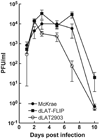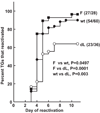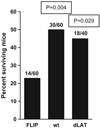Cellular FLIP can substitute for the herpes simplex virus type 1 latency-associated transcript gene to support a wild-type virus reactivation phenotype in mice
- PMID: 18989818
- PMCID: PMC2980827
- DOI: 10.1080/13550280802216510
Cellular FLIP can substitute for the herpes simplex virus type 1 latency-associated transcript gene to support a wild-type virus reactivation phenotype in mice
Abstract
Latency-associated transcript (LAT) deletion mutants of herpes simplex virus type 1 (HSV-1) have reduced reactivation phenotypes. Thus, LAT plays an essential role in the latency-reactivation cycle of HSV-1. We have shown that LAT has antiapoptosis activity and demonstrated that the chimeric virus, dLAT-cpIAP, resulting from replacing LAT with the baculovirus antiapoptosis gene cpIAP, has a wild-type HSV-1 reactivation phenotype in mice and rabbits. Thus, LAT can be replaced by an alternative antiapoptosis gene, confirming that LAT's antiapoptosis activity plays an important role in the mechanism by which LAT enhances the virus' reactivation phenotype. However, because cpIAP interferes with both of the major apoptosis pathways, these studies did not address whether LAT's proreactivation phenotype function was due to blocking the extrinsic (Fas-ligand-, caspase-8-, or caspase-10-dependent pathway) or the intrinsic (mitochondria-, caspase-9-dependent pathway) pathway, or whether both pathways must be blocked. Here we constructed an HSV-1 LAT(-) mutant that expresses cellular FLIP (cellular FLICE-like inhibitory protein) under control of the LAT promoter and in place of LAT nucleotides 76 to 1667. Mice were ocularly infected with this mutant, designated dLAT-FLIP, and the reactivation phenotype was determined using the trigeminal ganglia explant model. dLAT-FLIP had a reactivation phenotype similar to wild-type virus and significantly higher than the LAT(-) mutant dLAT2903. Thus, the LAT function responsible for enhancing the reactivation phenotype could be replaced with an antiapoptosis gene that primarily blocks the extrinsic signaling apoptosis pathway.
Conflict of interest statement
Figures







References
-
- Boldin MP, Goncharov TM, Goltsev YV, Wallach D. Involvement of MACH, a novel MORT1/FADD-interacting protease, in Fas/APO-1- and TNF receptor-induced cell death. Cell. 1996;85:803–815. - PubMed
-
- Brugha R, Keersmaekers K, Renton A, Meheus A. Genital herpes infection: a review. Int J Epidemiol. 1997;26:698–709. - PubMed
Publication types
MeSH terms
Substances
Grants and funding
LinkOut - more resources
Full Text Sources
Medical
Research Materials
Miscellaneous

